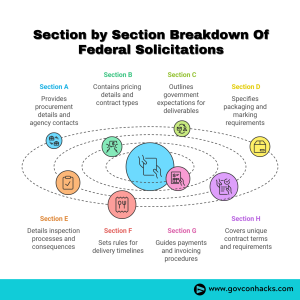Introduction
Navigating federal solicitations can feel overwhelming, especially if you’re new to the marketplace. Whether labeled as a “Request for Quote,” “Invitation for Bid,” or “Request for Proposal,”—it can be tediously lengthy, packed with legalese, and filled with easily overlooked information. To succeed as a federal contractor, understanding the structure of a solicitation is non-negotiable to avoid losing your sanity.
Does that mean every part of the solicitation is equally essential? Not necessarily. But knowing what to expect and how to quickly identify deal-breaking details can save you time and help you focus on crafting a winning proposal.
Let’s examine the standard structure of federal solicitations, which are typically organized into 13 sections (A through M).
Section-by-Section Breakdown
Section A: Information to Offerors or Quoters
This section covers procurement details, set-aside programs, and agency contacts. It’s often just one page, but it’s crucial—it includes the signature page that binds the contract once awarded.
Section B: Supplies or Services and Price/Costs
This is the section where you’ll find pricing details. It includes contract line items (CLINs), billing info, contract type (like firm-fixed-price), and any potential options. It may be formatted differently from solicitation to solicitation (a table format or a list), but essentially, if it involves money, it’s probably here.
Section C: Statement of Work (SOW)
Think of this section as “the what” – what the government expects you to deliver, whether it be products or services. You will refer back to this several times throughout writing your proposal.
Section D: Packages and Marking
Here’s where the government will tell you how to package, where to mark, and destination information. From classified handling to quirky requirements (like purple packing peanuts), this section will spell it out—though details may vary by task order.
Section E: Inspection and Acceptance
This section explains how deliverables will be inspected and what happens if they’re late or rejected. Spoiler: delivering late isn’t great for your CPARS.
Section F: Deliveries or Performance
Timing is everything, and this section sets the rules. It includes periods of performance and any FAR provisions tied to deliverables. Work start dates? Transition phases? You’ll find them here.
Section G: Contract Administrative Data
Here’s the “how-to” guide for payments and invoicing. It also tells you who you’ll be working with on the agency side. If you want to get paid smoothly, this section is your friend.
Section H: Special Contract Requirements
This section is a catch-all for unique contract terms, such as key personnel requirements, background checks, or cybersecurity protocols. Pay close attention—it often contains make-or-break details.
Section I: Contract Clauses/General Provisions
All the fine print lives here. This section includes applicable FAR clauses, audit rights, and reporting requirements. If it’s legalese-heavy, you’re probably in Section I.
Section J: Attachments and Exhibits
This is essentially the appendix. It lists all exhibits, attachments, and supplemental documents, helping you quickly find specific references.
Section K: Representations, Certifications, and Statements of Offerors
Here’s where you certify eligibility to bid—think small business status, taxpayer ID, or ownership details. It’s legally binding, so double-check your entries. Your SAM registration responses typically suffice for Section K. Be sure to answer any questions manually that you answered in SAM with “Vendor will provide with specific offers to government.”
Section L: Proposal Preparation Instructions
Formatting your proposal wrong could disqualify you. Section L covers submission guidelines, page limits, required volumes, and deadlines. Pro tip: Submit questions by the deadline listed here!
Section M: Evaluation Criteria
This section tells you how proposals will be scored—whether the agency uses best value (balancing technical factors and price) or lowest price technically acceptable (where price reigns supreme). Study this section carefully; it’s your roadmap to winning.
Why Knowing the Structure Matters
Understanding how solicitations are organized makes evaluating opportunities faster and easier. Some agencies might not follow the Uniform Contract Format (UCF), but they usually have their own logical structure. Learning to navigate these documents efficiently will save time and help you focus on contracts aligning with your business goals.
For the official breakdown of the UCF, check out FAR 15.204-1 et seq.
Need help navigating solicitations? Email us at [email protected], and let’s chat! For more free resources, check out our GovConHacks Podcast.


